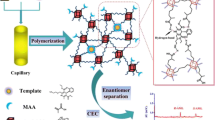Abstract
Cyclodextrins were cross-linked with toluene 2,4-diisocyanate in dimethyl sufoxide in the presence of hydrophobic biomolecules as templates, and the imprinted polymers were applied to the stationary phases of high performance liquid chromatography. Molecular imprinting efficiently promoted the binding-affinity and substrate-selectivity towards the template molecule, compared with the control polymers prepared in their absence. When cholesterol (template molecule) was complexed with cyclodextrins prior to the polymerization, for example, the imprinted polymer retained cholesterol more strongly than other steroids. Upon the polymerization without a template molecule, the binding towards steroids was much weaker. Besides steroids, imprinting was effective for various hydrophobic and rigid template molecules. Since binding of the guest molecule was based on inclusion complex formation with cyclodextrins, separation could be achieved in the solvents containing water. These polymeric receptors are also applicable to selective recognition of biologically important molecules or removal of toxic molecules from aqueous media. Thus, imprinting of cyclodextrins is useful for the preparation of synthetic tailor-made receptors for various kinds of hydrophobic guest molecules.
Similar content being viewed by others
References
(a) J.-M. Lehn: Supramolecular Chemistry, VCH, Weinheim, (1995); (b) M.M. Conn and J. Rebek Jr.: Chem. Rev. 97, 1647 (1997).
(a) J. Vicens and V. Bohmer: Calixarenes. A Versatile Class of Macrocyclic Compounds, Kluwer Academic Publishers, Dordrecht, The Netherlands (1991); (b) J. Vicens, Z. Asfari and J.M. Harrowfield: Calixarenes 50th Anniversary Commemorative Volume, Kluwer Academic Publishers, Dordrecht, The Netherlands (1994); (c) H.S. Park, Q. Lin and A.D. Hamilton: J. Am. Chem. Soc. 121, 8 (1999).
P. Wallimann T. Marti A. Furer F. Diederich (1997) ArticleTitle␣ Chem. Rev. 97 1567
(a) M.L. Bender and M. Komiyama: Cyclodextrin Chemistry, Springer-Verlag, Berlin (1978); (b) J. Szèjtlí, Cyclodextrin Technology, Kluwer Academic Publishers, Budapest (1988); (c) K.A. Connors, Chem. Rev. 97, 1325 (1997); (d) A. Harada, Adv. Polym. Sci. 133, 141 (1997).
M.R. Jong Particlede J.F.J. Engbersen J. Huskens D.N. Reinhoudt (2000) ArticleTitle␣ Chem. Eur. J. 6 4034
M. Komiyama T. Takeuchi T. Mukawa H. Asanuma (2003) Molecular Imprinting, From Fundamental to Applications Wiley-VCH ␣
(a) D.A. Spivak and K.J. Shea: Macromolecules 31, 2160 (1998); (b) K.J. Shea and D.Y. Sasaki: J. Am. Chem. Soc. 113, 4109 (1991); (c) M.J. Whitcombe, M.E. Rodriguez, P. Villar, and E.N. Vulfson: J. Am. Chem. Soc. 117, 7105 (1995); (d) B. Sellergren, J. Wieschemeyer, K.S. Boos, and D. Seidel: Chem. Mater. 10, 4037 (1998); (e) B. Sellergren: Angew. Chem., Int. Ed. Engl. 39, 1031 (2000); (f) M.E. Davis, A. Katz, and W.R. Ahmad: Chem. Mater. 8, 1820 (1996); (g) O. Ramström and K. Mosbach: Curr. Opin. Chem. Biol. 3, 759 (1999); (h) G. Wülff: Angew. Chem., Int. Ed. Engl. 34, 1812 (1995); (i) T. Takeuchi and J. Haginaka: J. Chromatogr. B 728, 1 (1999); (j) J. Matsui, Y. Miyoshi, O. Doblhoff-Dier and T. Takeuchi: Anal. Chem. 67, 4404 (1995); (k) S.A. Piletsky, H.S. Andersson and I.A. Nicholls: Macromolecules 32, 633 (1999).
(a) H. Asanuma, T. Hishiya and M. Komiyama: Adv. Mater. 12, 1019 (2000); (b) H. Asanuma, T. Akiyama, K. Kajiya, T. Hishiya, and M. Komiyama: Anal. Chim. Acta 435, 25 (2001); (c) H. Asanuma, K. Kajiya, T. Hishiya, and M. Komiyama: Chem. Lett. 665 (1999).
(a) T. Hishiya, M. Shibata, M. Kakazu, H. Asanuma, and M. Komiyama: Macromolecules 32, 2265 (1999); (b) T. Hishiya, H. Asanuma, and M. Komiyama: J. Am. Chem. Soc. 124, 570 (2002).
At a higher ratio of water in the eluent, peaks were too broadened to determine retention times precisely.
The peaks were rather broad as observed in the conventional imprinting. However, the retention times could be precisely determined.
These chromatographic results are consistent with those obtained from batch-wise adsorption assay reported in [9].
NOE was observed between CyD molecules and the guest (p-terphenyl) in DMSO, indicating that inclusion complex was formed during polymerization. UV spectrum was also changed (peak shift was observed) on addition of β-CyD in DMSO.
Phenoxathiin is similar in structure to dioxin compounds except for the lack of halogen atoms.
Author information
Authors and Affiliations
Corresponding authors
Rights and permissions
About this article
Cite this article
Asanuma, H., Hishiya, T. & Komiyama, M. Efficient Separation of Hydrophobic Molecules by Molecularly Imprinted Cyclodextrin Polymers. J Incl Phenom Macrocycl Chem 50, 51–55 (2004). https://doi.org/10.1007/s10847-003-8838-4
Received:
Accepted:
Issue Date:
DOI: https://doi.org/10.1007/s10847-003-8838-4




